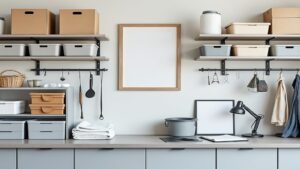Effective storage solutions are crucial for maintaining an organized and functional living environment. Whether you’re moving into a new home or looking to optimize an existing space, strategic planning can help you make the most of your storage areas. This guide will provide detailed insights into planning and implementing storage solutions to accommodate all your belongings efficiently.
Learn how to plan and implement effective storage solutions to enhance organization and functionality in your home. This guide covers various storage types, design tips, and maintenance advice.
Understanding Your Storage Needs
Evaluating What You Have
Before diving into storage solutions, assess your current storage situation:
- Inventory Your Items: Take stock of what you need to store, from clothing and kitchenware to tools and documents.
- Assess Available Space: Measure your rooms, closets, and any other potential storage areas.
- Determine Usage: Identify how often you use certain items to prioritize their placement.
Setting Storage Goals
Establish clear goals for your storage solutions:
- Maximize Efficiency: Ensure that your storage system enhances accessibility and organization.
- Improve Aesthetics: Choose designs that blend well with your home’s decor.
- Optimize Space: Make the most of available space without creating clutter.
Types of Storage Solutions
1. Closets and Cabinets
Closets and cabinets are foundational storage solutions that offer flexibility for various needs.
Built-In Closets
- Pros:
- Customizable to fit specific spaces
- Seamlessly integrated with your home’s design
- Cons:
- May require professional installation
- Limited by existing wall structures
Freestanding Cabinets
- Pros:
- Portable and adaptable to different rooms
- Available in numerous styles and sizes
- Cons:
- Occupies additional floor space
- May not always match your home’s decor
2. Shelving Units
Shelving units are versatile and can be used for a range of items, from books to decorative objects.
Wall-Mounted Shelves
- Pros:
- Saves floor space
- Adjustable and customizable to fit your needs
- Cons:
- Requires wall space for installation
- Installation can be complex and may require tools
Freestanding Shelves
- Pros:
- Easy to reposition and reconfigure
- Available in a variety of styles and sizes
- Cons:
- Takes up floor space
- Can be less stable if not properly secured
3. Under-Bed Storage
Under-bed storage utilizes the space beneath your bed for items like seasonal clothing or extra linens.
- Pros:
- Maximizes unused space effectively
- Keeps items hidden from view
- Cons:
- Access can be challenging, especially if the bed is low
- Not suitable for heavy or bulky items
4. Multi-Functional Furniture
Multi-functional furniture integrates storage with everyday use, such as ottomans with hidden compartments or beds with built-in drawers.
- Pros:
- Saves space by combining functions
- Reduces clutter and enhances utility
- Cons:
- May be more costly than traditional furniture
- Design flexibility might be limited
5. Garage and Basement Storage
Garage and basement storage can handle larger items and tools, but organization is key to avoiding clutter.
Shelving and Racks
- Pros:
- Organizes tools and equipment efficiently
- Provides easy access to frequently used items
- Cons:
- Requires careful space planning
- Can accumulate dust and moisture
Storage Bins and Containers
- Pros:
- Protects items from dust and damage
- Stacks easily and organizes effectively
- Cons:
- Can become disorganized if not labeled properly
- Requires sufficient space for storage
Designing Effective Storage Solutions
Maximizing Space Efficiency
To make the most of your storage design:
- Use Vertical Space: Install shelves or cabinets up to the ceiling.
- Custom Solutions: Design storage to fit specific needs and spaces.
- Accessibility: Ensure items you use frequently are easy to reach.
Integrating Storage with Home Design
Make sure your storage solutions blend seamlessly with your home’s decor:
- Color Coordination: Match storage units with your interior color scheme for a cohesive look.
- Design Aesthetics: Choose styles that complement your home’s design.
- Hidden Storage: Incorporate concealed storage options to maintain a clean and uncluttered appearance.
Budget Considerations
Keep your budget in mind when planning storage:
- Cost vs. Benefit: Compare the cost of custom solutions with off-the-shelf options.
- DIY Options: Consider DIY projects for cost savings.
- Long-Term Value: Invest in durable solutions that offer lasting benefits.
Maintaining an Organized Storage System
Regular Decluttering
Keep your storage system functional with regular maintenance:
- Routine Checks: Regularly review items and remove what you no longer need.
- Seasonal Updates: Adjust storage for seasonal items and activities.
Effective Labeling
Labeling helps keep your storage organized:
- Clear Labels: Use easy-to-read labels for bins and shelves.
- Consistent System: Implement a labeling system to easily identify and locate items.
Conclusion
Planning and implementing effective storage solutions can significantly improve your home’s functionality and aesthetics. By carefully assessing your needs, choosing appropriate storage types, and integrating them with your home’s design, you can create a system that enhances both organization and comfort. Regular maintenance and smart organization strategies will ensure your storage remains effective and your home stays clutter-free.
By following this comprehensive guide, you’ll be equipped to create a well-organized and efficient storage system tailored to your needs, making your living space more comfortable and functional.

